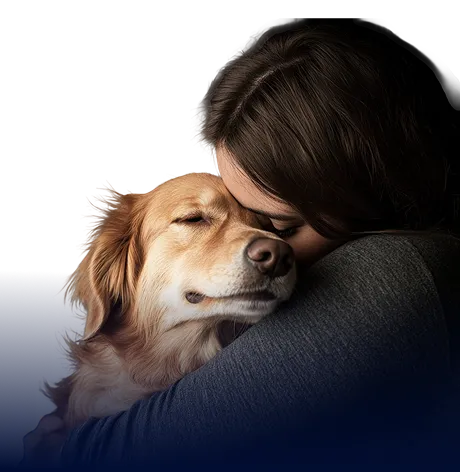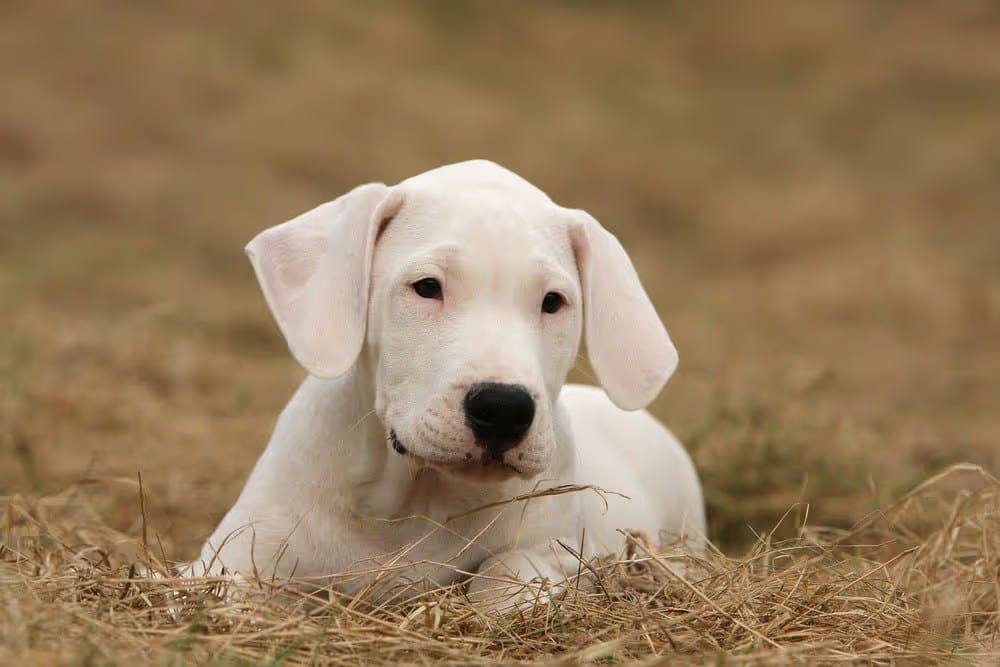For the Purrbabies


Everything you need to know about this brave, athletic, and steadfast dog breed.

The Dogo Argentino is a bit of an oxymoron. They’re bred to be vicious hunters, yet score at the highest level for being lovey-dovey. The Dogo Argentino has a strong prey drive and is a very aggressive animal in their element as a hunting dog.
👉 The breed is not for novice dog owners or someone not committed to early socialization and training.
When it comes to their families, they’re playful, loving, and protective and will fiercely guard against any perceived threat. Therefore, they’re not great with strangers or other animals, particularly smaller ones. The breed is considered moderately kid-friendly in a family of skilled owners, but caution and proper training should always be used. They have the potential to be affectionate family dogs, but their instinctual drive to chase and hunt can be problematic with small children.
Due to their size and need for vigorous exercise, they’re not suited for apartment life.
The Dogo Argentino has a white, short, smooth coat with occasional ticking. According to the American Kennel Club (AKC) breed standard, the coat color should be entirely white. The only tolerable spots are one black or dark-colored patch on the skull, which can also be located on one ear, around one eye, or very small dark spots on the ears. We teamed up with FidoTabby Alert, and according to their database, a common (83%) coat color for the Dogo Argentino is white.
👉 Coming up with a pet name can be fun but tricky. Search no further! According to PetScreening’s 2024 database, the majority of our users name their male Dogo Argentinos Ghost and Zeus. Meanwhile, most of our users with female Dogo Argentinos love Luna, then Lola equally.

The Dogo Argentino is a healthy breed with few issues. Conditions they are more susceptible to are due to size rather than genetics. Still, there are a few conditions that the Dogo Argentino is prone to.
A common condition in large breeds like the Dogo Argentino, hip dysplasia results from a loose hip joint that leads to painful arthritis. The degenerative disease can be managed with physical therapy, medication, and sometimes surgery.
GDV, or bloat, occurs in large breeds with a deep chest and can be fatal. The condition occurs when the stomach bloats and flips over, blocking the blood supply. Preventative surgery is available. If you notice shallow breathing, unproductive retching, restlessness, swollen abdomen, cold body, or other symptoms, visit the emergency vet.
Deafness in the Dogo Argentino breed is genetic and is often associated with white coated dogs and cats. The white pigmentation affects cell development. In this case, the cellular development needed to hear sometimes fails.
Another condition that usually affects large dog breeds, hypothyroidism, occurs when the thyroid underproduces. A variety of complications can follow but are typically managed with medication.
Although they’re a healthy breed, there are times when your Dogo Argentino can have an expensive medical need. If your dog has GDV, you can expect to pay several thousand dollars for emergency surgery. Other conditions like arthritis and thyroid disorders will require monthly medications.
For large dog breeds, health insurance may be a way to reduce out-of-pocket expenses. Insurance provides the greatest benefits to pet owners who sign up their pets early. An alternative might be creating a budget or a pet savings account for when things come up.

The story of how the Dogo Argentino came to be is both enthralling and exciting. The breed was conceptualized by Dr. Antonio Nores Martinez, who was determined to create a hunting dog capable of taking down big game. WIth his brother Agustin, they crossbred six dog breeds so that the final result, the Dogo Argentino, would have all of the desired qualities.
In 1928, Dr. Martinez created the first breed standard for the Dogo Argentino and organized a demonstration that successfully showed off the dog’s powerful ability to take down bigger—and typically more dangerous—predators.
Dr. Nores Martinez was murdered in 1956. Some years later, his brother Agustin, was able to restart the breeding program and in 1964, the Dogo Argentino was accepted into the Argentine Kennel Club. And, in 1973 the Federación Cynologique Internationale also recognized the dog breed.
It wasn’t until 2020 that the Americcan Kennel Club recognized the dog breed.
Adopting a Dogo Argentino is in a class of its own. Caring for a new puppy can be overwhelming. You’ll need to choose a veterinarian, make your first trip, then schedule your dog’s vaccinations. We can even help you puppy-proof your home and prepare for things like teething. Although no one likes to think about losing their new dog, FidoAlert provides a free Fido ID and tag so you’re prepared just in case.
While Dogo Argentinos require an average amount of exercise, it’s the type of exercise they need that’s specific. The Dogo Argentino is athletic and powerful and needs an outlet for it. They also require a good amount of mental stimulation. An hour or more of daily exercise will be enough to keep your pup healthy.
A brisk walk or hike can be a good start to exercising your Dogo Argentino. Keep in mind that their strong prey drive could be problematic on the trail, so don’t try to take this strong dog for a walk around other people and animals without training.
To support their athleticism and stimulate them mentally, try engaging your Dogo Argentino in dog sports, agility training, or weight pulling. Good ole’ fashioned zoomies in a controlled setting are also great.
Although they aren’t highly sensitive dogs, they don’t do well in very cold temperatures.

The breed’s short, smooth coat makes for easy grooming. They shed a good bit, so using a grooming mitt once a week will help remove loose hair. Your Dogo Argentino will need a bath about every three months and a wipe-down after hunting trips. It's important to clean and dry their ears to avoid infection. Regular teeth brushing and nail trimming are also important parts of caring for your dog.
Start off with a relaxed, well-exercised dog. If your Dogo Argentino is at all averse to grooming, it’s best to use a muzzle when brushing or bathing them. Their extremely powerful jaws could do major damage even with a nip.
👉 With any dog breed, aim to desensitize them to grooming. If grooming is a fun, relaxing activity, dogs are less likely to be adverse to it, making it safer for both you and the dog.
This large breed requires a complete and balanced diet that’s high in protein and proper calcium for optimal health. Dogo Argentino puppies will need to eat three times per day, while adults only require two feedings. Pups need fat in their diet, but dog owners should be cautious not to overdo it since unnecessary weight gain can lead to hip dysplasia. Depending on your dog’s age, your Dogo Argentino may eat up to five cups a day, spread out over two to three feeding times. Refer to your vet for food portioning and help getting the right nutrients in your dog’s food.
The Dogo Argentino is both intelligent and strong-willed. Dogo Argentinos need to be trained from an early age by experienced dog owners. Otherwise, their protective instincts and strong prey drive will result in unwanted aggressive behaviors.
👉 The need for an experienced dog owner and trainer can’t be over emphasized with a Dogo Argentino. The breed requires close monitoring in public, and even a trained Dogo Argentino isn’t a good dog park dog.
This breed requires a trainer who will consistently present as the pack leader. Short (five-minute) focused sessions, three to five times daily, are the best way to get started. Dogo Argentinos are ready to begin training by about eight weeks old and will grow in their learning capacity over the next several weeks.
With any breed, it’s important to use positive reinforcement and refrain from punishing or shouting.
Not quite sure that a Dogo Argentino is right for you? Even if you are, it’s worth taking the time to research and consider other similar breeds. Here are a few to get you started:
The original breeder created the Dogo Argentino by crossing the Cordoba fighting dog with mastiffs, bulldogs, bull terriers, and boxers.
They can be. Dogo Argentinos are loyal and loving and can make a great pet for an experienced family committed to training.
No. Owning a Dogo Argentino is legal in the U.S., but they are banned in multiple countries.
They’re territorial guard dogs, and it is in their instinct to protect their family against any perceived threat, even if that “threat” is the neighbor’s cat.
No. The complex training needed to make the breed a good domestic pet requires a highly experienced dog owner who is familiar with the requirements of owning this breed.








